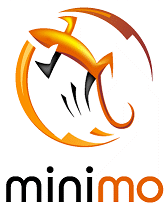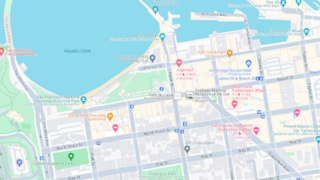
AutoCAD is a commercial computer-aided design (CAD) and drafting software application. Developed and marketed by Autodesk, AutoCAD was first released in December 1982 as a desktop app running on microcomputers with internal graphics controllers. Before AutoCAD was introduced, most commercial CAD programs ran on mainframe computers or minicomputers, with each CAD operator (user) working at a separate graphics terminal. AutoCAD is also available as mobile and web apps.
Microsoft Windows, commonly referred to as Windows, is a group of several proprietary graphical operating system families, all of which are developed and marketed by Microsoft. Each family caters to a certain sector of the computing industry. Active Microsoft Windows families include Windows NT and Windows IoT; these may encompass subfamilies,. Defunct Microsoft Windows families include Windows 9x, Windows Mobile and Windows Phone.

Wine is a free and open-source compatibility layer that aims to allow application software and computer games developed for Microsoft Windows to run on Unix-like operating systems. Wine also provides a software library, named Winelib, against which developers can compile Windows applications to help port them to Unix-like systems.
In computing, cross-platform software is computer software that is designed to work in several computing platforms. Some cross-platform software requires a separate build for each platform, but some can be directly run on any platform without special preparation, being written in an interpreted language or compiled to portable bytecode for which the interpreters or run-time packages are common or standard components of all supported platforms.

A wallpaper or background is a digital image used as a decorative background of a graphical user interface on the screen of a computer, smartphone or other electronic device. On a computer, wallpapers are generally used on the desktop, while on a mobile phone they serve as the background for the home screen. Though most devices come with a default background image, modern devices usually allow users to manually change the background image.

NASA WorldWind is an open-source virtual globe. According to the website, "WorldWind is an open source virtual globe API. WorldWind allows developers to quickly and easily create interactive visualizations of 3D globe, map and geographical information. Organizations around the world use WorldWind to monitor weather patterns, visualize cities and terrain, track vehicle movement, analyze geospatial data and educate humanity about the Earth." It was first developed by NASA in 2003 for use on personal computers and then further developed in concert with the open source community since 2004. As of 2017, a web-based version of WorldWind is available online. An Android version is also available.

Minimo was a project to create a version of the Mozilla web browser for small devices like personal digital assistants and mobile phones.

Windows Mobile is a discontinued family of mobile operating systems developed by Microsoft for smartphones and personal digital assistants.

Google Maps is a web mapping platform and consumer application offered by Google. It offers satellite imagery, aerial photography, street maps, 360° interactive panoramic views of streets, real-time traffic conditions, and route planning for traveling by foot, car, bike, air and public transportation. As of 2020, Google Maps was being used by over 1 billion people every month around the world.

Google Earth is a computer program that renders a 3D representation of Earth based primarily on satellite imagery. The program maps the Earth by superimposing satellite images, aerial photography, and GIS data onto a 3D globe, allowing users to see cities and landscapes from various angles. Users can explore the globe by entering addresses and coordinates, or by using a keyboard or mouse. The program can also be downloaded on a smartphone or tablet, using a touch screen or stylus to navigate. Users may use the program to add their own data using Keyhole Markup Language and upload them through various sources, such as forums or blogs. Google Earth is able to show various kinds of images overlaid on the surface of the earth and is also a Web Map Service client. In 2019, Google has revealed that Google Earth now covers more than 98 percent of the world, and has captured 10 million miles of Street View imagery.

Bing Maps is a web mapping service provided as a part of Microsoft's Bing suite of search engines and powered by the Bing Maps for Enterprise framework.

BumpTop was a 3D desktop environment that simulates the normal behavior and physical properties of a real-world desk and enhances it with automatic tools to organize its contents. It is aimed at stylus interaction, making it more suitable for tablet computers and handheld PCs. It was created at the University of Toronto as Anand Agarawala's master's thesis. Agarawala also gave a presentation at the TED conference about his idea. The 1.0 version was released on April 8, 2009, along with a fully featured pro version as a paid upgrade. On April 30, 2010 the author announced that BumpTop was being discontinued and that they were taking the software "in an exciting new direction." Two days later, it was announced that the company had been acquired by Google. On January 5, 2011, Google released a sneak preview video of Android 3.0 Honeycomb showing a 3D desktop with features purportedly taken from BumpTop.
Satellite navigation software or GPS navigation software usually falls into one of the following two categories:
- Navigation with route calculation and directions from the software to the user of the route to take, based on a vector-based map, normally for motorised vehicles with some motorised forms added on as an afterthought.
- Navigation tracking, often with a map "picture" in the background, but showing where you have been, and allowing "routes" to be preprogrammed, giving a line you can follow on the screen. This type can also be used for geocaching.

A site-specific browser (SSB) is a software application that is dedicated to accessing pages from a single source (site) on a computer network such as the Internet or a private intranet. SSBs typically simplify the more complex functions of a web browser by excluding the menus, toolbars and browser chrome associated with functions that are external to the workings of a single site. These applications are typically started by a desktop icon which is usually a favicon.

Google Chrome is a cross-platform web browser developed by Google. It was first released in 2008 for Microsoft Windows, built with free software components from Apple WebKit and Mozilla Firefox. It was later ported to Linux, macOS, iOS, and Android, where it is the default browser. The browser is also the main component of Chrome OS, where it serves as the platform for web applications.

Navit is a free and open-source, modular, touch screen friendly, car navigation system with GPS tracking, realtime routing engine and support for various vector map formats. It features both a 2D and 3D view of map data.

The Motorola Xoom is an Android-based tablet computer by Motorola, introduced at CES 2011 on January 5, 2011. It was the first tablet to be sold with Android 3.0 Honeycomb. The Verizon branded Xoom was the first tablet to run Android 3.1. The Motorola Xoom went through the FCC on February 10, 2011 only 14 days before release. The 3G version was released on February 24, 2011, and the Wi-Fi version was released March 27, 2011. It was announced concurrently with three other products: the Motorola Atrix, the Motorola Droid Bionic, and the Motorola Cliq 2. CNET named it the "Best of the CES" 2011.

Android Studio is the official integrated development environment (IDE) for Google's Android operating system, built on JetBrains' IntelliJ IDEA software and designed specifically for Android development. It is available for download on Windows, macOS and Linux based operating systems or as a subscription-based service in 2020. It is a replacement for the Eclipse Android Development Tools (E-ADT) as the primary IDE for native Android application development.

Kubity is a cloud-based 3D communication tool that works on desktop computers, the web, smartphones, tablets, augmented reality gear, and virtual reality glasses. Kubity is powered by several proprietary 3D processing engines including "Paragone" and "Etna" that prepare the 3D file for transfer over mobile devices.













